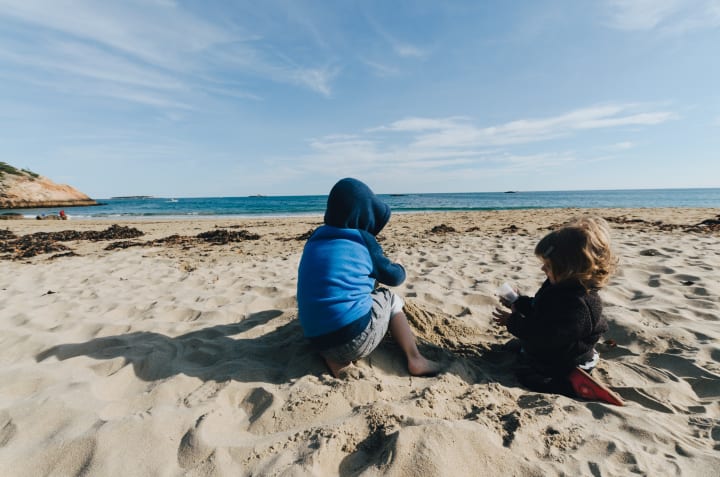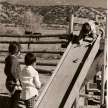Playtime is Precious
The importance of giving children time to play

Children need a great deal of unstructured play time. This is the time when their imaginations can soar. They learn to navigate the world around them, increase vocabulary, learn to negotiate with peers and interact with adults and many different materials. Remember, for young children everything is new! Everything we adults take for granted is an adventure into the unknown for the small child. During play time whether at home or at school, the children need to have the space, materials and encouragement to try new things and explore. Adults can play crucial roles in helping them develop new skills by integrating themselves into the child's play instead of directing the play. By letting the child direct the play, and asking questions, making observations and encouraging them the children can be guided to learn new skills, new vocabulary, many facts and understand many roles of the people, animals and plants in the world around them.
Small children often participate in what is called parallel play. This is when the children create their own project or game independently, but purposely do it next to each other even though there is little direct interaction between the children. This type of play is perfect for guiding children and helping explore new materials. The adult can simply start their own project next to a busy child. For example, if the child is working at the playdough table, the adult can sit next to the child and begin working on a sculpture of their own. Talking quietly to themselves the adult can explain the process he is using to create a snake or a pinch pot. If the child looks interested in what the adult is doing the adult can gently engage them in conversation about the sculpture the child is creating. This allows the adult to expand the child’s use of the material and increase the child’s vocabulary without directly imposing upon the child’s own work. It also provides an example of how to have a conversation and gives the child a chance to express pride in the work he is doing.

When asking about a child’s work, a good ice breaker is to ask if there is a story. Often a child will happily tell a story while painting a picture, building with blocks or sculpting with playdough. It is important to be specific when talking about a child’s work. A compliment that is general like “great painting”, does not do justice to what the child is trying to express. It is much better to say, “I like the way you used red paint in that corner of your picture” or “what is happening in your picture?” or “Wow! Your blocks are as tall as you are!”
I once remarked to two children engaged in parallel play in the block area that they were working hard and I liked the way they were sharing the blocks. B pointed proudly to his sprawling creation and said, “I’m building Walsenburg!” And G piped up, “And I am building Pueblo! See how the road goes here and if you go down and down the road a long time you get to Pueblo!”
These two children had independently created a three-dimensional map of the two towns they were familiar with and then connected them with a highway of blocks. The “towns” were even proportional, with Pueblo being much larger and taking up more space than the smaller town of Walsenburg. Yet when I observed them working, there was very little direct interaction between the children until I starting asking them about their work.
There is a quote I have seen over the years that is so very true. I am not sure who said it first, but “play is a child’s work” is an important truth to keep in mind. Children need to play. When they play, they are doing the important work that helps them make sense of the world around them. Their brains need to physically act out the roles of the adults around them to understand their place in the family, in the school, in the community. They need to be firemen, bad guys, policemen, Mommies and Daddies. It is how they learn about the world around them, they act it out in play. This is how they grow their vocabulary, learn compassion, learn how their body moves and explore material, they play. Even in a school setting, two thirds of the day should be child directed play with many choices in materials. Much of the teacher or adult directed work should also be based on play. Such as teaching rhymes, stories, fingerplays, songs and games. All of these fun things directly teach important skills such as listening, problem solving, morals, manners, taking turns, sharing, counting, body parts, emotions, etc.
Learning should be fun. It should be developmentally appropriate not only for that age group, but for that particular child since every child develops at their own pace. It should open up a world of wonder and excitement and that shouldn’t end with third grade, it should continue into adulthood and beyond.

Magda Gerber, a child therapist says, “spontaneous, self-initiated activities have an essential value. The pleasure evolving from exploration and mastery is self-reinforcing, and the infant becomes intrinsically motivated to learn.” The bulk of her work is with infants, but this is true for children of all ages. Children who are allowed to satisfy their curiosity and to grow and learn at their own unique pace become lifelong learners that enjoy the process of learning well into their adult years.
Everything is new when a child is born. Everything they see, hear, touch, taste, or smell is a brand new, exciting experience. They need to have the time and the safe spaces required to really explore and understand this new world they have entered. They need unconditional love and acceptance for who they are and what they are capable of doing without pressure to perform. They need to play!
Playtime is precious, it is important, it is the foundation for all learning.
About the Creator
Morgan Alber
I taught preschool and reading for 19 years in a small rural school in Southern Colorado.
I have a B.S. degree in Biology, an AA in Anthropology, and a Master Herbalist Degree.
When I am not playing with my granddaughter, I love to read.






Comments
There are no comments for this story
Be the first to respond and start the conversation.